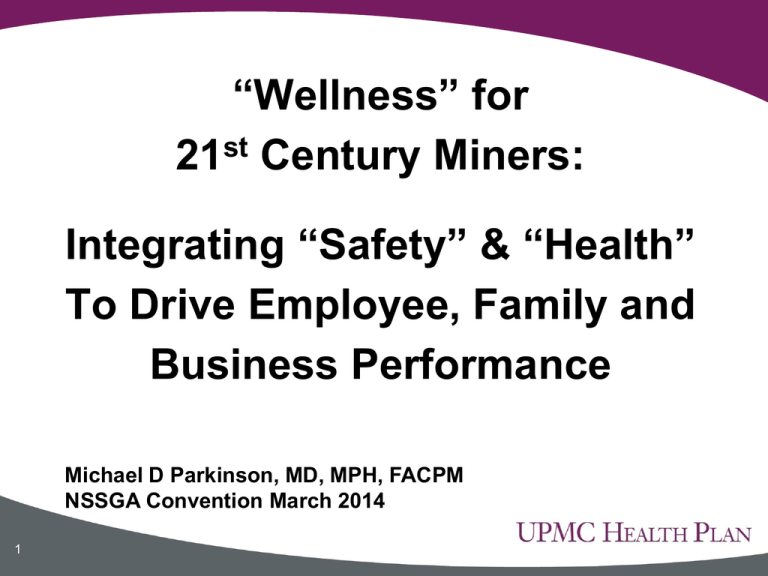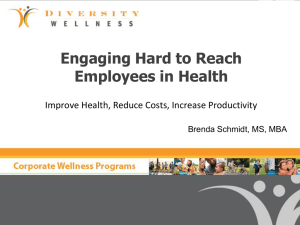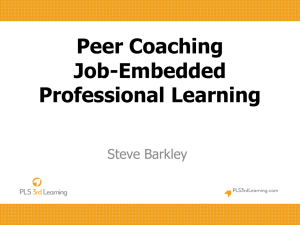
“Wellness” for
21st Century Miners:
Integrating “Safety” & “Health”
To Drive Employee, Family and
Business Performance
Michael D Parkinson, MD, MPH, FACPM
NSSGA Convention March 2014
1
Objectives
• Definition of 21st century “wellness” for industry, employers
and employees in globally competitive economy
• Military, NASA and private sector applications
• Integration of “Safety”, “Health Protection” and “Health
Promotion”
– NIOSH Total Worker Health™ initiative
• Employer Health & Productivity Roadmap
• Implications for 21st century mining industry, employers,
miners and their families
2
My Perspective: Always Achieving the Mission
•
Air Force flight surgeon
•
•
Chief, US Air Force Preventive Medicine
•
•
•
Deliver or “buy” care from private sector for 2M beneficiaries
What functions are “mission-essential” for health, safety, performance?
President, American College of Preventive Medicine
•
•
•
•
Optimizing preventive medical care programs for Air Force and DOD pre-, during
and post- Persian Gulf operations
Study and medical surveillance of occupational and environmental health risks
Deputy Director, Air Force Medical Operations and MHS leadership
•
•
•
Mission achievement worldwide thru “whole person” orientation to worklife,
professional and personal integration for hi-risk aircrew and families
Physicians in public health, preventive care and occupational medicine
Institute of Medicine NASA “Integrating Employee Health” 2 yr study
Consumer-directed health care – prevention paid 100%
NIOSH Total Worker Health Advisor U of Iowa
3
$2.6 T: 75% Behaviors, 30% Waste
What are We Trying To Do Anyway?
5
21st Century Mining and Related Industry
•
•
•
•
•
•
Global scope and competition
24-7 high risk, high impact industry
Critical growth path and opportunities
Increasingly short “cycle time” to react and change
Safety and quality paramount
Mission critical personnel with time, attention, physical and
mental health demands
• Health and performance – similarly critical to global success
and company growth
6
How Many Americans Can Just Say “Yes” to All 5?
I am within 5 pounds of my ideal body weight
I exercise 30 minutes or more most days of week
I eat a healthy diet with 5 fruits/vegetables most days
I don’t use tobacco products
I have 2 or fewer alcoholic drinks per day
7
“Health Promotion” or “Health Protection” . .
“Occupational” or “Non-Occupational” . . A Picture Worth . . .
Mediterranean (or Asian) Diet + Nonsmoker +
Daily Activity + Moderate Alcohol Use*
Reduction
Compared to U.S.
Comment
Heart Disease
64%*−83%**
80% due to modifiable risk
factors
Cancer
60%*
Approximates NCI
estimates
Diabetes
91%**
No type 2 epidemic
All-cause Mortality
50%*
25 year Okinawa program
—similar findings
Disease
* Knoops et al and **Rimm, Stampfer, JAMA 2004;292:1433-1439
9
Determinants of “Health” and “Disease”
Where & How We Live, Learn, Work and Play
Social
Environment
Individual
Response
--Behavior
--Biology
Health
&
Function
Physical
Genetic
Environment Environment
Disease
Well-Being
Health
Care
Prosperity
Evans, R. G., Barer, M. L., & Marmor, T. R. (1994)
10Some People Healthy and Others Not?. New York: Aldine De Gruyter
Why Are
F100 Engine Performance Threats
Flight Hour Periodic Maintenance Schedule
4th Stage
Compressor Blade
3rd / 4th LPT Disk / Blade
3rd Fan Disk / Blade
#5 Bearing Compartment
HPT Distress
Compressor Stalls
Fuel Manifold Pigtails/Flex Hoses/Nozzles
11
Human System Performance Threat
Mission-essential Preventive Maintenance?
Atherosclerosis
Environmental
Stress-Induced
Human
System Performance Threats Toxin Exposure
Disorders
Back Injury
Suicide
Operational
Demands
Hearing
Loss
Accidental Injury
Injury/Illness From
Infectious
Hostile Attack
Disease Hypertension
Committee to Assess
Worksite Preventive
Health Program Needs
of NASA EmployeesThe
National Academies
Institute of Medicine
Food and Nutrition Board
http://www.iom.edu/CMS/3788/18021/269
95.aspx
13
Institute of Medicine:
What Does A Healthy Workforce Look Like?*
• HEALTHY
– Demonstrating optimal health status as defined by positive health
behaviors; minimal modifiable risk factors; and minimal illnesses,
diseases, and injuries
• PRODUCTIVE
– Functioning to produce the maximum contribution to achievement of
personal goals and the organizational mission
• READY
– Possessing an ability to respond to changing demands given the
increasing pace and unpredictable nature of work
• RESILIENT
– Adjusting to setbacks, increased demands, or unusual challenges by
bouncing back to optimal “well-being” and performance without
incurring severe functional decrement.
IOM: Integrating Employee Health: A Report for NASA 2007
14
Behaviors Drive Medical, Disability, Absenteeism,
Worker’s Comp, &Total Employer Costs
$7,123
$5,813
$4,530
$4,401
$7,000
$3,216
$6,000
$4,718
$2,098
$5,000
$3,364
$3,894
$4,000
$2,667
$2,912
$1,550
$2,110
$1,351
$2,941
$3,000
$2,000
$1,000
$1,122
$1,523
$2,081
$3,069
$2,480
$2,605
$2,200
Medium Risk
$1,851
$1,641
Non-Participant
Low risk
$0
19-34
High Risk
35-44
45-54
55-64
65-74
75+
Edington. Am J Health Promotion 15(5):341-349, 2001
Strategy To Address Rising Medical Costs and
Improve Workforce Health & Productivity
Health Risk
High Risk Criteria
Alcohol Use
More than 2 drinks / day
Blood Pressure
Systolic > 139 mmHg or
Diastolic > 89 mmHg
Body Weight
Men BMI > 27.8; Women
BMI > 27.3
Total
Cholesterol
Greater than 239 mg/dl
Existing Medical
Condition
Heart, Cancer, Diabetes,
Stroke
HDL
More than 5 days last
year
Life Satisfaction
Partly or Not Satisfied
Physical Activity
Smoking
Stress
Moderate
Risk
High
Risk
Poorly
Managed
Less than 35 mg/dl
Illness Days
Perception of
Health
Low
Risk
Well
Managed
62%
26%
Medical
Cost
$3,273/yr
$5,971/yr
$9,221/yr
Integrated
Cost
$4,621/yr
$8,022/yr
$13,057/yr
Fair or Poor
Less than one time/week
Current smoker
High
MAINTAIN
12%
8%
$7,000/yr
IMPROVE
• 20% drive 80% of cost – but not the same 20%. 50% of those are new each year.
• Average employee has 2.2 health risks, resulting in $2,000/yr in productivity losses. (JOEM, 2005)
• 36% of absence – including STD and Workers’ Comp – is due to excess risk factors (JOEM, 2002)
2%
$14,000/yr
MANAGE
When Done Right: Positive ROI for Both
Direct Medical and “Indirect” Total Costs
• Medical costs fall by about $3.27 for every dollar spent
on effective wellness programs
• Absenteeism costs fall by about $2.73 for every dollar
spent
Cost Declines per Dollar Spent
Medical Costs
Absenteeism
$2.40
$2.60
$2.80
$3.00
Source: Katherine Baicker, David Cutler, and Zirui Song, Health Affairs, February, 2010
$3.20
$3.40
NASA Recommendation “Job 1”: A New Vision
• The success and sustainability of an integrated health
process must first and foremost begin with a clear
understanding of the organization’s mission.
• The Committee recommends that the administrator of
NASA adopt a new vision for worker health, readiness,
and resilience that directly links to NASA’s mission and
includes health as a core NASA value that is
implemented through an integrated health and systems
approach.
18
NASA #2: Link Health and Performance to
Bottom Line and Mission
A mission-driven vision for health should
articulate why investment in health and
employee-integrated health helps NASA
achieve its core mission on time, under
budget, and better than expected.
19
NASA #3: Visible Organizational Commitment
•
Develop a data-based approach to policy, planning,
programming, budgeting, implementation, operations,
evaluation, and management.
•
Create a standardized “health and performance” full-cost
accounting framework to define, standardize, prioritize,
fund, and evaluate resource allocation for human-related
mission performance and workplace safety, health, and
productivity.
•
Incorporate mission-essential elements of integrated
health programs in contracting requirements.
20
NASA #4: Manager Education and Ownership
NASA should provide education and
training to first-line managers and
supervisors that focuses on the
relationship between health and
productivity
21
NIOSH Total Worker Health™: Integrating Health,
Prevention, Safety and Occupational Medicine
• Total Worker Health™ is a strategy integrating occupational
safety and health protection with health promotion to prevent
worker injury and illness and to advance health and well-being.
• “Most diseases, injuries, and other health conditions experienced by
working people are multifactorial, especially as the workforce ages.
Evidence supporting the role of work and personal risk factors in the
health of working people is frequently underused in developing
interventions. Achieving a longer, healthy working life requires a
comprehensive preventive approach. To help develop such an
approach, we evaluated the influence of both occupational and
personal risk factors on workforce health.”
•
Interaction of Occupational and Personal Risk Factors in Workforce Health and Safety,
AJPM Mar 2012 Schulte et al
22
Employer Health & Productivity Road Map™ *
“Understand, Improve, and Partner With Your Doctor”
Optimize
Environment
Increase
Healthy
Behaviors
Minimize
Acute
Care
Optimize
Chronic
Care
Reduce
Excessive
Surgery
Speed
Transitions
Care-HomeWork
Incentivized Health Management Program or
Consumer-Directed Health Plan
*Parkinson MD. Employer Health and Productivity Roadmap™ J Occup Environ Med 2013;55 (12):
Total Worker Health Supp S46-51.
Copyright 2013 UPMC Health Plan. All rights reserved.
Employer Health & Productivity Road Map
“Understand, Improve & Partner With Your Doctor”
Optimize
Environment
Increase
Healthy
Behaviors
Minimize
Acute
Care
• Health and Productivity Alignment Assessment
Report and Gap Analysis
• Health & Performance Total Economic
Opportunity
• Ergonomic evaluation and support
• Wellness Course Participation
24
Optimize
Chronic
Care
Reduce
Excessive
Surgery
Speed
Transitions
Care-HomeWork
Health and Productivity Performance Index Assessment
Health and Productivity
Performance Index (HAPPI)
Leadership/Culture
Communications
Incentives
Rewards
Alignment
Programs &
Services
The HAPPI assessment was developed from
Best in Class tools to help employers identify
areas for improvement and health related cost
savings.
Fit-Friendly Worksites
Physical
Environment
Ergonomics,
Facilities &
Safety
Employer Health & Productivity Road Map
“Understand, Improve & Partner With Your Doctor”
Optimize
Environment
Increase
Healthy
Behaviors
Minimize
Acute
Care
Optimize
Chronic
Care
• “Champion Index” - % in optimal health
• Population risk profile & movement
• Biometric changes over time
• Clinical preventive services
• Lifestyle coaching enrollment & graduation
26
Reduce
Excessive
Surgery
Speed
Transitions
Care-HomeWork
Understand Your Health and
“Know Your Numbers”
Provided in partnership
with
Health
Web
Portal
Work site
Health
Programs
Health
Coaching
HRA
Biometric
Screenings
Coaching & Competitions Work
Health
Web Portal
Worksite
Health
Programs
Health
Coaching
HRA
Biometric
Screenings
Employer Health & Productivity Road Map
“Understand, Improve & Partner With Your Doctor”
Optimize
Environment
Increase
Healthy
Behaviors
Minimize
Acute
Care
Optimize
Chronic
Care
• Visits/1000 by site of traditional and
alternative care
• Video and e-visits
• Lower cost and onsite care options
• Prevalence of impactable acute
visits
29
Reduce
Excessive
Surgery
Speed
Transitions
Care-HomeWork
Norman Rockwell Had It Right!
“Medical Home” Re-visited
30
I Still Want “My Rockwell”
But My Way, My Time, For Less $$
31
Move “Care Forward”: Where Its Most Needed –
Not Where Most Comfortable
Employer Health & Productivity Road Map
“Understand, Improve & Partner With Your Doctor”
Optimize
Environment
Increase
Healthy
Behaviors
Minimize
Acute
Care
Optimize
Chronic
Care
Reduce
Excessive
Surgery
Speed
Transitions
Care-HomeWork
• Condition prevalence
• Identification & referral process
− % “active” self-identification
− % ”passive” outreach
• Disease Management Coaching:
− enrollment & graduation
33
“Prescribe Engagement” – and We “Fill the Prescription”
Health Coaching for Lifestyle, Disease and Shared Decision-making
Chronic Condition
Management
Asthma
COPD
Diabetes
Depression
Cardiac conditions
Low Back Pain
Surgery SDM for
back, hip, knee
• Evidence- & curriculum-based program/services
• Individual and tele-group coaching
• Coach supported self-study
(online & workbook options)
• Coach-on-Call e-mail & video
new
Onsite Health
Coaching
Lifestyle Improvement
MyHealth Eating Well™
MyHealth Ready to Quit™
MyHealth Weigh to
Wellness™
MyHealth Less Stress™
MyHealth Step Up to
Wellness™
MyHealth Selections™
34
Employer Health & Productivity Road Map
“Understand, Improve & Partner With Your Doctor”
Optimize
Environment
Increase
Healthy
Behaviors
Minimize
Acute
Care
Optimize
Chronic
Care
Reduce
Excessive
Surgery
Speed
Transitions
Care-HomeWork
• Shared decision-making before
surgery with interactive online tool
• Best practice step therapy pathway for
low back pain
• Reduce:
− Number of low back surgeries
− Advanced imaging rate
• Expand to more preference-sensitive
discretionary surgeries and conditions
35
Primary Care Physicians’ Opinions of Patients’ Need
To Be Informed vs Actual Proportion Informed by
Medical Service Type*
CA screenings
Having surgery
Taking new Rx's
Changing behaviors
Manage chronic condition
0%
Pts Actually Are Informed
20%
40%
60%
80%
100%
Important for Pts to Be Informed?
*Foundation for Informed Medical Decision Making
survey, 2009 (n=462)
National Priorities for Shared Decision Making:
Reduce unwarranted procedures, targeting:
• Spine surgery
• PTCA/Stent
• Knee replacement
• Hip replacement
• Lumbar spine MRI prior to conservative therapy, without red flags
• Bone or joint x-ray prior to conservative therapy, without red flags
• Coronary artery bypass graft (CABG)
• Hysterectomy
• Prostatectomy
• Cesarean section
• Endoscopy
• Others
Employer Health & Productivity Road Map
“Understand, Improve & Partner With Your Doctor”
Optimize
Environment
Increase
Healthy
Behaviors
Minimize
Acute
Care
Optimize
Chronic
Care
Reduce
Excessive
Surgery
Speed
Transitions
Care-HomeWork
• Top 4-5 conditions that
drive Time Away From Work
• Absence changes over time
• Leave management
38
Coordination of “Stove-piped” Programs Decreases
Absenteeism, Lowers Total Costs & Improves Productivity
Employee
Assistance Program
Partners Program
(Medical Home)
Incentive Driven
Wellness Program(s)
Member Services
24/7 Nurse Line
Pharmacy
Outreach
39
Worksite Health
Clinics
Improve
Health
Health
Management
Coaching
• Lifestyle/Wellness
• Physical Condition
Management
• Behavior
Condition
Management
• Complex Case
Management
Maintain
Health
Manage
Health
Central Leave
Management/FMLA
Short-Term
Disability
Workers’ Compensation
Employer Health & Productivity Road Map™ *
“Understand, Improve, and Partner With Your Doctor”
Optimize
Environment
Increase
Healthy
Behaviors
Minimize
Acute
Care
Optimize
Chronic
Care
Reduce
Excessive
Surgery
Speed
Transitions
Care-HomeWork
Incentivized Health Management Program or
Consumer-Directed Health Plan
*Parkinson MD. Employer Health and Productivity Roadmap™ J Occup Environ Med 2013;55 (12):
Total Worker Health Supp S46-51.
Copyright 2013 UPMC Health Plan. All rights reserved.
Powering the Health & Productivity Road Map:
Moving to Maximally Effective Health and Cost Savings
Increasing Consumer and Patient Engagement
HSA only – full replacement
HRA/HSA – full replacement
HRA only – full replacement
Financial
Efficiency
$$
HRA/HSA/Hybrid – optional
HSA only – optional
HRA only – optional
PPO with Incentivized Comprehensive Health Management
PPO with or without “Wellness Program”
Migration Toward Consumer-Driven Health Care
41
Copyright 2013 UPMC Health Plan. All rights reserved.
Rewarding Healthy Choices & Better Care Decisions
Understand
Improve
Partner
Consumer
Engages in
Health and Care
Activities
$
UPMC
Health Plan
incentivizes
the member
“Understand, Improve and Partner”
Incentivized Strategy to Optimize Engagement
• Health Risk Assessment
• Biometric Screening
• Flu Shot
• Lifestyle & disease management
coaching
• Preventive Screenings
• Partner with your Doctor
• Shared decision-making
• Care delivery innovations – connectivity
and eVisits
• Earn up to $500/$1000 to use
toward your Deductible and
Coinsurance
43
Wellness, Health, Safety: Integration Saves Lives & Costs
44
Take Homes For 21st Century Mining “Performance”
• Integrated health, safety, performance, bottom line savings
and top line growth all tied to productive employees
• Define what hi-performing mining workforce “looks like”
using IOM 4 key elements – then shoot for goal
• Preventive care should be standardized, emphasized,
assured and measured as key component of “human
performance” and achievement of corporate mission
• The field, federal government and leading employers
understand emphasis on “total worker health” paradigm
Health/wellness AND safety/occupational health – one and same
• To maximize company and industry productivity – maximize
personal and family health, fitness and performance
45









